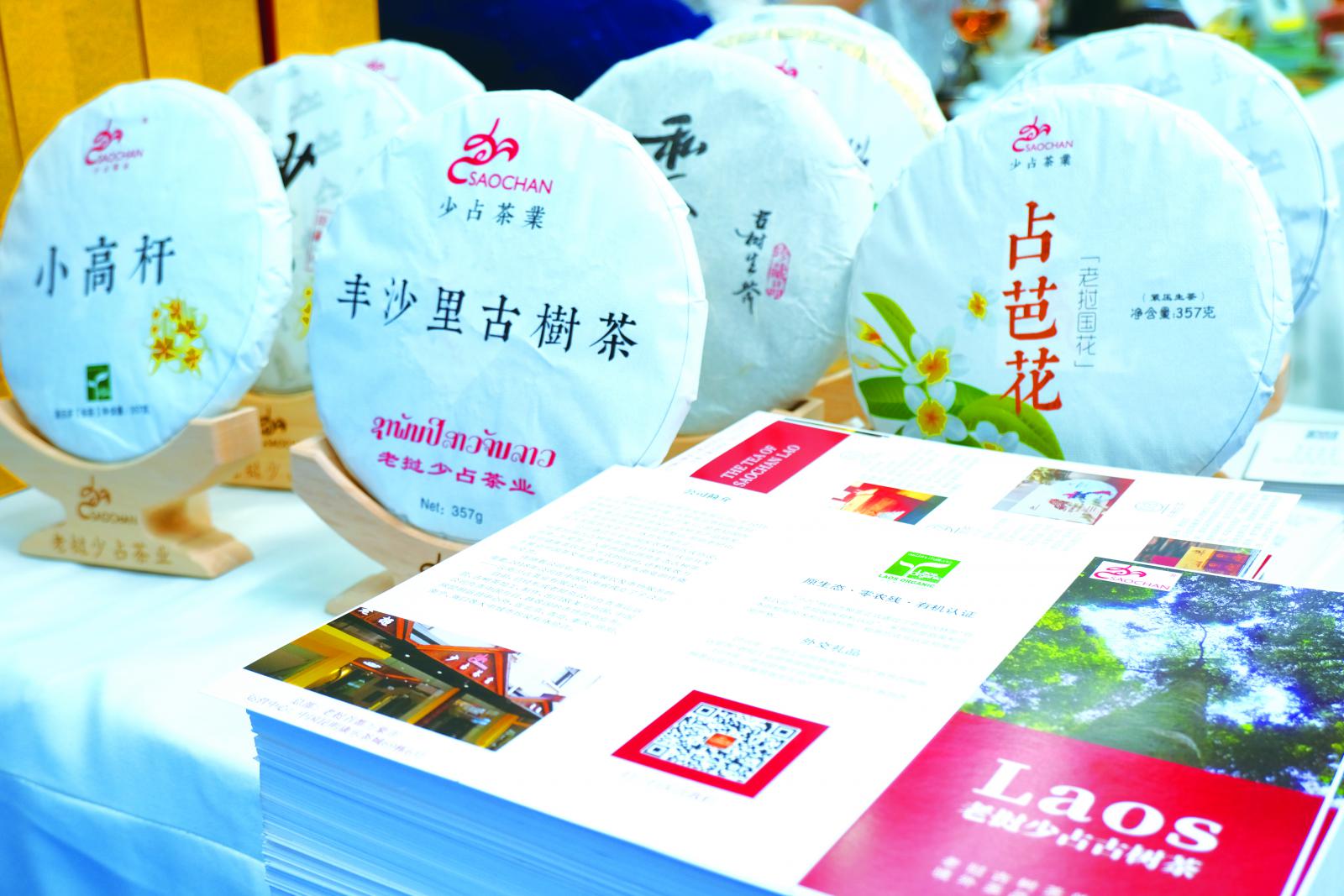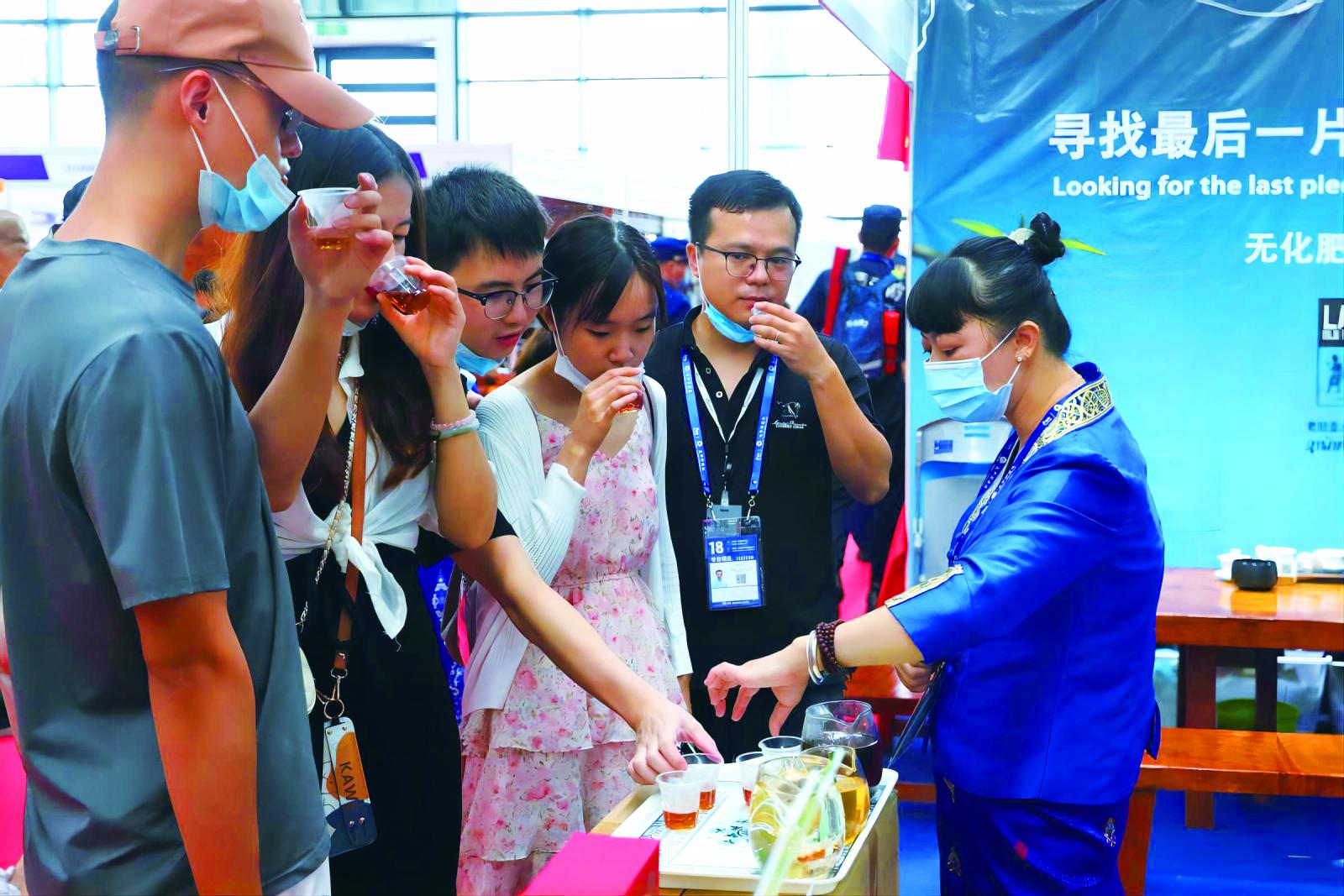

Written by Li Min & Zhang Shirui / Translated by Wen Xiaqing
During the 19th China-ASEAN Expo (CAEXPO), plenty of visitors were attracted early in the morning to the Laos Pavilion. Many of them were sitting at the table set by Laotian tea merchants, savoring cups of tea and chatting. It has been years since the Laos old tree tea exhibition area in the Pavilion buzzes with visitors while other booths see only several.
Relishing in pleasant tea fragrance, people in the Pavilion have casual chats, share the latest news in the Laos tea circle, or repeat old stories. During their talks, stories could range from how hundreds of ancient tea trees came from near destruction to lush groves in the mountains comparable in size to other state-owned forests. Their topics begin at the CAEXPO, and their wishes go far beyond tea cooperation between China and Laos.

CAEXPO bridges people, businesses, and exchanges
As the only landlocked country in Southeast Asia, Laos is long marked by its zero industry and under-developed economy compared with other ASEAN member countries. It is, however, an overture to its huge growth potential.
In 2006, Zhou Jinfu, a tea lover who started drinking tea in his 17, walked into the exhibition hall of the 3rd CAEXPO as he neared retirement. When passing by the Laos Pavilion, where only a few goods were exhibited, Zhou couldn’t help thinking about the considerable gap between Laos’ rich land resources and its limited exports to China. Finally, he got a chance to go on a business trip to Laos. Thanks to his impeccable taste in tea drinking, Zhou eventually chose ancient tea trees grown in the primary forest and started a new journey to protect, exploit and promote them. When it turned to the 18th CAEXPO, old tree tea in the Laos Pavilion, for the first time, beat mahogany, emerging as the same business card to the high-quality agriculture of Laos. All these couldn’t be true without the joint efforts of the local government, residents, and Zhou.
As Laos borders the Yiwu Tea region of Yunnan in the north, its substantial tea trees are said to be the result of cross-border merchants who traveled out of Yunnan to do business by the Tea Horse Road. Back then, horses and carriages were still able to pass. They then sowed patches of big-leaf tea seeds at the road’s south section and left them to grow in lush, which is why Laos today owns substantial tea resources. However, these old trees, some of which are 300 or even 1370 years old, were either felled for wood, burned to make way for land, or left unattended in dense forests, for the locals didn’t have a habit of tea drinking or the expertise in tea picking and processing.
“Statistics show that 9000-hectare tea trees were cut down to around 2,000 hectares in 2010,” said Zhou. A few years after his first trip, Zhou embarked on a path that alleviated the poverty of the locals through tea picking and processing industrial chains while balancing protection and growth, which won the approval and trust of the locals; he also gradually developed a business model, in which tea products were some sold in the domestic market while some exported to China after he set up factories in Laos and warehouses in China. In 2015, Zhou, at the invitation of the Ministry of Industry and Commerce of Laos, led a group of exhibitors to the CAEXPO for the first time and introduced the old tree tea to the public in Nanning, the capital city of the Guangxi Zhuang autonomous region. Once the tea debuted at the expo, it was welcomed by an avalanche of orders. And as a bridge between peoples, it also fired both countries’ enthusiasm for the healthy product that benefits from Chinese techniques and the pleasant Laotian climate.
Since then, old tree tea has become a regular visitor to the Pavilion with increasingly various brands and categories. Among all Laotian exhibitors, some are Laotian Chinese who are confident and assured back home after their ambitious trips out, owing to the international business platform and increasingly conducive exhibition channel that CAEXPO offers.
Up-and-coming brands take off in CAEXPO
In the 19th CAEXPO, Lao Ambassador to China Khamphao Ernthavanh promoted in person to the media and people from all walks of life the old tree tea, now a “national drinking” exclusive to government departments for greeting distinguished guests.
Furthermore, old tree tea brands, such as Gold Champa, Saochan, and Charms of Laos, which enjoy both popularity and a good reputation at the expo, have shifted to a more flexible tea plantation economy thanks to preferential policies: all brands gain governmental certification on each link from tea picking to promotion, and some are exempt from duty.
According to Vientiane Times reports, Laos tea production exceeded 19,000 tons from 2019 to 2022, bringing back 1.5 million USD after being exported as processed products. Moreover, Laos’ first tea expo kicked off in Luang Prabang in March 2023, attracting exhibitors from not only traditional tea-producing provinces like Phongsalli, Xayaburi, and Xieng Khouang but also emerging tea plantations in provinces such as Champasak. “In 2022, we have exported about 60,000 tons of old tree tea to the Chinese market, with an average annual growth rate of 20 % over the past five years. And we are busy with constant buyers when the tea gains wider popularity,” said Mr. Bounyadeth Thongsavanh, Director General of the Department of Industry and Commerce of Champasak Province, Laos.
The growing awareness of healthcare and healthy food can explain why the old tree tea of Laos gets a good piece of the market. And owing to its pristine, pollution-free, and organic growing environment, the newcomer is deemed as a growth stock and captures more and more attention in the tea circle.
Xiao Yunfeng, a Laos tea merchant, was captured on film by a journalist from the Guangxi Radio and Television, in which he elaborated on how to produce scented old tree tea while keeping primeval forests intact, and behind him was a group of joyous tea fans who are waiting in patience for a taste of the legend eco-tea. Some tea lovers feel compelled to buy several cans of tea for its lingering sweet taste, which is also true for tea merchant Zhang Chaohui, whose tea was snapped up soon at its debut in the expo. “The first time I came to the CAEXPO was the 13th session in 2016. Each year since then, I see more and more exhibitors coming,” said Zhang. As an exhibitor who has participated for consecutive years, she witnessed old tree tea’s enormous opportunities at the expo and gained the confidence to promote her brand in the global market. Now she has developed dealers and agents from places like Hubei, Chongqing, Beijing, and Sichuan, with products exported to foreign markets, including Europe, the United States, Japan, and South Korea.
Thanks to the CAEXPO, an influential platform that offers broad coverage and efficient coordination, Laos old tree tea has built up its confidence and strength to present itself on other platforms, and it has also appeared on the menu of Beijing’s well-established Lao She Teahouse, welcomed by tea maniacs across the nation; as the old tree tea gradually secures its name as a national brand at the overseas market, it appears at trade fairs around the globe together with other distinctively ASEAN products — Vietnamese coffee, Malaysian Cubilose, and Philippine pineapple — to establish closer ties with more tea enthusiasts.
CAEXPO provides continuous benefits for its enterprises
In 2022, the Regional Comprehensive Economic Partnership Agreement (RCEP) took full effect. Since then, it brought about an upgraded regional economic and trade network, which promoted understanding of the issue in the region, and bolstered the morale of people from all walks of life to ponder on the improvement of cooperation quality and efficiency.
In the 19th CAEXPO, Zhang was still here, busy serving tea to guests while occasionally chatting with old acquaintances. She expected each session of CAEXPO, for it was the starting point of her career and a firm base from which she could hit the road to pursue prosperity. Zhang based her company in Xieng Khouang Province, one of the three major tea-producing regions. And Xieng Khouang, too, showed up at the expo as the Laos’ City of Charm, mirroring increasingly close exchanges in the tea trade and peoples between the two nations.
Deng Lianghui, representative of the Ministry of Industry and Commerce of Laos to the 19th CAEXPO, introduced at the site of an agricultural industrial park that was scheduled to be set up in Xieng Khouang. The Park, centering on investment and cooperation in tea and agriculture, was to seize the opening of the China-Laos railway to optimize the layout of bilateral warehousing and logistics parks and further cooperation in the tea industry based on Xieng Khouang’s sister city relationship with Wuzhou, Guangxi.
Owing to the friendly tie knotted in 2015, similar tea resources, and cooperation outcomes in developing infrastructure, Xieng Khouang and Wuzhou built up the strength to embrace new cooperation. Such win-win business outcomes and industrial cooperation vision between the two places are facilitated by the CAEXPO, which provides a platform and room for a high-quality development mindset, too.
As a much-told saying goes, the excellent Laos tea is made in China. The praise reflects the concrete economic and trade outcomes brought about by the “Nanning Channel” CAEXPO since Nanning was chosen as the expo’s permanent venue; it also represents the fruitful agricultural cooperation secured in trade and economic exchange; moreover, it witnesses the friendly tie of two peoples since China and Laos established diplomatic ties. In a future where negotiations on the 3.0 version of the ASEAN-China Free Trade Area are ongoing, and the RCEP comes into full force and advances, the region’s industrial chain layout will be optimized, and the transportation network, upgraded. All these will continue to unleash the commercial potential of Lao's old tree tea — the gift from its pristine forests — in the tea market.

桂ICP备14000177号 Copyright@2006-2013 Guangxi China-ASEAN Panorama Magazine Agency Co., Ltd. All Rights Reserved